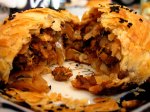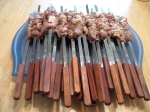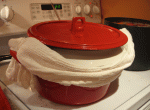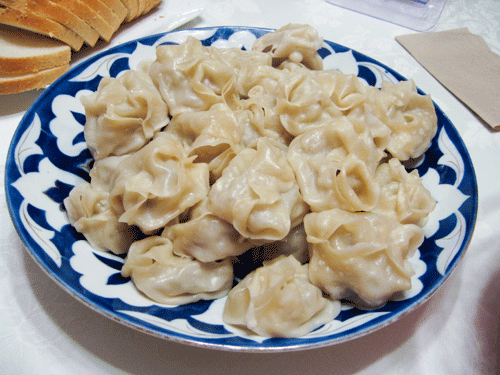Ok, as promised, now to the food….

Lagman
My dad ordered Lagman. I love lagman (pronounced: lah-g-mahn, with emphasis on the last syllable). I subconsciously tried making it when I was adding my own twist on a chili recipe I read on the back of a can of beans. And I’ve made it myself quite a few times and you can check out my version. It has carrots and celery (though I don’t know how authentic the celery is and I never use it) and noodles and red bell peppers and lamb. Dad liked it. And it had scallions as a garnish.

Mastava
This time around, I ordered Mastava (I think that’s how that soup is called and spelled and if I’m wrong, please let me know). It was delicious. The lamb was very well prepared, so tender it melted in your mouth as you ate it. No need to chew, really. Just inhale…. It had rice, lamb, carrots and other stuff I forgot about. And specks of emerald cilantro garnished the soup. Really good. Authentic. Notice how my sentences tend to shrink when the food is really fabulous. Probably because that’s all my mind is capable of at that moment and all the other mental powers are reserved to fully experiencing the decadence of the food. Love the flecks of cilantro garnishing most dishes. Just try it…Very yummy. I might have to try to make this at home one of these days. I wonder if I have a recipe somewhere… Hmmm. Oh, and this is a half-portion. Notice the difference between the full portion of Lagman and the half portion here. Not a whole lot of difference.

Manti
Then we ordered manti. I’ve been wanting to try them here and so we did. There are several kinds on the menu, but we got the ones with lamb. Notice how huge these are; they were about the size of my fist, not like the ones we typically make. Also, notice that they’re served with sour cream and vinegar (the bottle behind the dish). You typically don’t mix the vinegar and sour cream, it’s either or. These were so right. I can’t say that about many places, but not many places claim to have Uzbek food. But these were sooooo good! And huge… The dough was a tad thick, but barely noticeable, and the meat was all good. The spices, meat to fat ratio, and all other aspects of manti were nearly perfect. I’d definitely recommend that dish to anyone.

Liver Shashlik - shish-kebab
We also ordered liver shashlik (shish-kebab). I think this specific type is called “djigar”, but I could be wrong. Someone correct me on this please. I don’t understand why it was served with the veggies. But ok. The onion is the authentic part of how it’s typically served. None of us liked this dish. It was too dry.

Liver Shashlik - shish-kebab
See in the picture how dry it was? It should be a lot more pink in the middle. It was like rubber; a workout for our knives and teeth. I hope they improve this. When it’s right, it melts in your mouth and has a very nice mouth feel, like pate. When it’s right even a baby/toddler could eat it.

Shashlik - shish-kebab
Next, we tried “regular” shashlik. I must say that this is made from beef and not lamb, that’s why it’s in quotes. It’s as “regular” as you can have there. This is a hit or miss dish. The first time I had it I didn’t like because it had some weird spices. The server must have heard me describe that and had the kitchen leave it off this time so it was actually pretty good this time. It was seasoned and marinated properly and was very soft. Each skewer had plenty of meat and a serving is more than plenty.

Samsa - Uzbek dish
The first time I was at this restaurant I also tried samsa. It was pretty good, but not how I remember, but then again, it’s been more than 20 years since I’ve had an authentic samsa. And this one was also very huge. These portions are very filling.
So let’s start at the beginning.

Samsa - inside view
A samsa is a minced meat, fat, spices, and onion mixture that’s wrapped in dough and baked in a tandoori oven (tandyr). There are several kinds: rounds ones made from regular dough and triangular ones made of layered dough and not quite as tall as this one though they do puff up. This sucker was the size of my head! Not quite, but nearly. It also had more than onions for veggies but I couldn’t discern what all comprised the mixture. Still, it was very good. When made in a tandyr, the crust that forms on the bottom is very crunchy and the top is soft and when you bite into it, the juices run down your chin and the steam that escapes is like a sigh of contentment. I actually have a recipe that I’ve been thinking of trying for this.

Plov
And finally, what I always crave. Plov! This is definitely not for the weight-watching crowd. This thing is packed with most delicious calories. You got beef, fat, oil, rice, carrots, and other yummies. Don’t get me wrong, plov is worth it! This is my “holy grail”, something I really want to learn to make; I don’t have the correct pot for this (it’s cooked in a “kazan“, a cast-iron pot much like a dutch oven that’s not enameled). So if you know where I can get my hands on a kazan, PLEASE LET ME KNOW!
This dish alone is worth the trip (because I can’t make it home at the moment, not because it’s legendarily good). It’s the only consistently good dish I’ve had here (but I’ve only been here twice…) and I would go there just for it again, even if the meat was just a tad dry. That they use beef instead of lamb is not authentic but that substitution is made often enough. It’s good, but don’t get me wrong, any competent home cook can make something far better. My grandma’s plov is hands-down a thousand times better; it’s legendarily good. And I can’t even learn it (no kazan)! Grrrr! I tried a few times in an enameled cast iron pot, but everything sticks, so there’s burned rice on the bottom affecting the taste of everything else. But it was still edible.
Note: if you’re familiar with Indian cuisine, some things might look/taste familiar (like the use of lamb, rice, and spices). Uzbek food is delicately spiced, but not spicy-hot; it’s heavy on the meat and very filling. (With all that we ordered, we had a lot of leftovers.)
Bring an empty stomach and an open mind if you’ve never tried these dishes before.
























































